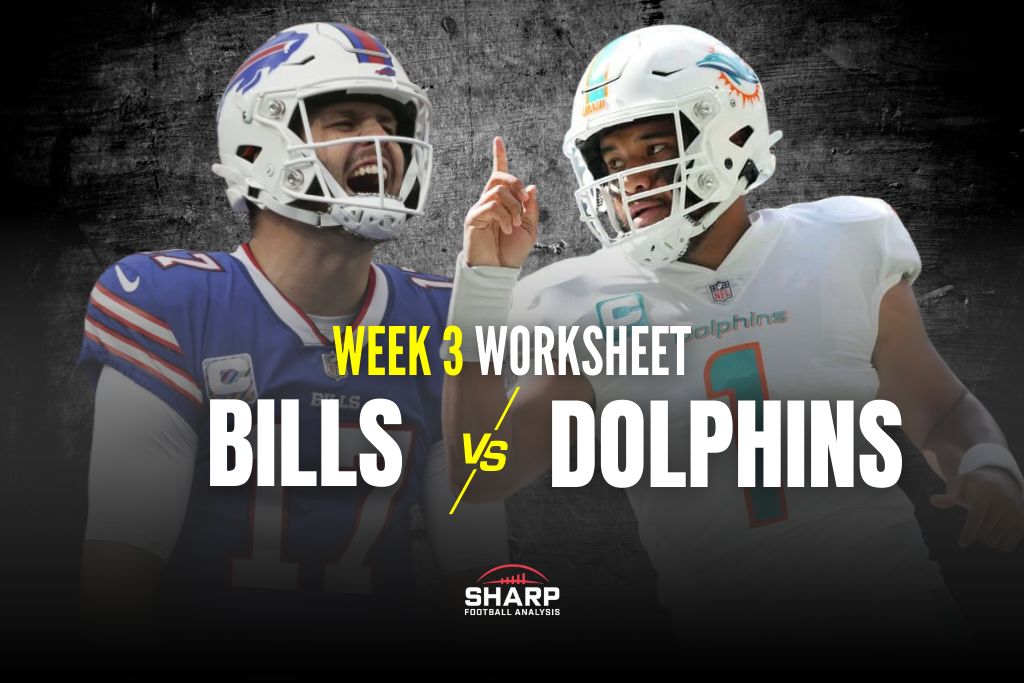The Worksheet, a comprehensive fantasy football preview by Rich Hribar, breaks down everything you need to know about the Week 3 matchup between the Bills and Dolphins on Thursday Night Football.
Find a breakdown of every Week 3 NFL game in our Worksheet Hub.
| Miami | Rank | @ | Buffalo | Rank |
|---|---|---|---|---|
| 12.5 | Spread | -12.5 | ||
| 18.5 | Implied Total | 31.0 | ||
| 17.5 | 25 | Points/Gm | 35.5 | 2 |
| 33.0 | 31 | Points All./Gm | 25.0 | 22 |
| 49.0 | 31 | Plays/Gm | 74.5 | 1 |
| 62.5 | 17 | Opp. Plays/Gm | 48.5 | 1 |
| 5.8 | 9 | Off. Yards/Play | 6.0 | 7 |
| 6 | 25 | Def. Yards/Play | 6 | 26 |
| 27.55% | 32 | Rush% | 49.66% | 6 |
| 72.45% | 1 | Pass% | 50.34% | 27 |
| 55.20% | 32 | Opp. Rush % | 51.55% | 28 |
| 44.80% | 1 | Opp. Pass % | 48.45% | 5 |
- The Dolphins are 1-6 against Buffalo under Mike McDaniel.
- Miami has the lowest defensive EPA in the league through two weeks (-26.03).
- The Bills have the most offensive EPA in the league through two weeks (31.28).
- Buffalo is tied for a league-high 6 plays of 30-plus yards on offense (6).
- Miami has one play of 30-plus yards, tied for the fewest in the league.
- Buffalo has won the turnover battle in 24 straight games, the longest streak in league history.
- The Dolphins are tied for the worst turnover margin in the league through two weeks (-4).
- Opponents have converted 51.9% (14 of 27) of their third downs versus Miami, the highest rate in the league.
- Miami has allowed 3.69 points per drive, the second most through two weeks for any team in the 2000s (behind the 2019 Dolphins at 3.83).
- The Dolphins have allowed points on 75% of opponent drives through two weeks, the highest rate for any team in the 2000s.
Trust = spike production for that player
Quarterback
Josh Allen (TRUST): Allen did not have to do a lot in Week 2, closing the week as QB21 (11.8 points).
After Allen had 51 dropbacks chasing points in Week 1, he only had 30 in Week 2.
The Bills' dropback rate dropped from 65.4% in Week 1 to 45.1% this past week.
Allen still rushed for 59 yards, but he threw for 148 yards and 0 touchdowns.
That will change this week.
Miami has already allowed Daniel Jones (29.5 points) and Drake Maye (26.3 points) to log top three scoring weeks against them through two weeks.
The Dolphins are 30th in passing points allowed per attempt (0.617), allowing 9.7 yards per pass attempt (30th), a league-worst 78.9% completion rate, and a 5.8% touchdown rate (25th) through two games.
Miami has been hyper aggressive for no gain.
The Dolphins have blitzed 44.4% of the time (second in the league) but rank 31st in pressure rate when blitzing (21.4%).
Additionally, Miami has allowed 14.6 and 9.1 rushing points to the quarterbacks they have faced.
Allen also has a strong history in this matchup.
He has closed as the average QB6 in weekly scoring for his career against Miami, averaging 27.1 fantasy points per game.
Tua Tagovailoa: Tagovailoa was able to show that this offense is not completely dead after a Week 1 catastrophe in Indianapolis.
Tagovailoa ended Week 2 as the QB15 (18.6 points), completing 81.2% of his passes (26 of 32) for 315 yards (9.8 Y/A) and 2 touchdowns.
He did throw another interception, his fourth turnover in two games.
The Buffalo defense turned things around quickly after being shredded by Baltimore in Week 1.
After allowing a league-high 11.0 yards per attempt and a 73.7% completion rate to open the year, Buffalo wiped away a Jets offense that looked strong in Week 1, allowing a league-low 3.8 Y/A and a 45.5% completion rate.
The Bills and Sean McDermott have had Tagovailoa's number.
In nine starts against the Bills, Tua’s highest-scoring weekly finish has been QB12.
He has averaged 13.1 fantasy points in his completed games against Buffalo, throwing 9 touchdowns to 10 interceptions and averaging 6.9 yards per pass attempt.
Tagovailoa is a floor-based QB2 option in Week 3.
Running Back
James Cook: Cook stayed hot to open the season, converting 22 touches into 135 total yards and adding 2 more touchdowns.
His afternoon was highlighted by a 44-yard touchdown run, his fifth touchdown run of 40 yards or more over the past two years.
Only Saquon Barkley has more (7).
While Cook continues to laugh in the face of scoring regression, he has beefed up his touches to open the season.
After 75% of the backfield touches in Week 1, Cook handled 66.7% in Week 2, but the blowout masked another leading workload.
Through three quarters, Cook received 22 of 28 (78.6%) backfield touches before sitting out the fourth quarter.
He had an opportunity to touch the ball on 62.9% of his snaps, third at the position in Week 2.
I believe that if we drafted again today, Cook would be at worst a second-round pick.
He is a fantasy RB1 attached to a home favorite.
Miami has not been as awful versus the run as the pass, but scoring chances will be on tap for a player with significant touchdown equity.
The Dolphins have allowed 4.1 yards per carry to running backs (17th) with a first down or touchdown on 18% of those runs (13th).
In the two matchups between these teams a year ago, Cook posted 95 yards and 3 touchdowns as well as 69 yards and 0 touchdowns.
De’Von Achane: Achane did not find much room to run with Miami missing Austin Jackson and James Daniels up front.
He rushed 10 times for 30 yards.
But as was the case a year ago, Miami was able to supplement its inability to run without a full line by utilizing Achane as a pass catcher.
He caught 8 of 10 targets for 92 yards and a touchdown.
He received 31.3% of the team’s targets.
Going back to last season, Achane has a 23.6% target share with a target on 26.5% of his routes when Tagovailoa is on the field.
Once again, we are not talking dump offs, either.
Achane lined up out wide for 10.2% of his snaps and in the slot for 24.5%.
He had a 29-yard touchdown grab on a Texas route and then nearly had a 46-yard touchdown that came back because he stepped out of bounds with just over a minute to go.
As long as Tagovailoa is active, Achane has an elevated floor through receiving, which adds to his appeal as an RB1 in full-PPR formats and a fringe RB1/RB2 in non-PPR formats.
Tagovailoa was active in both matchups with the Bills last year (he threw 25 times in the first matchup before leaving), and Achane was the RB2 in scoring in both of those weeks.
In those games, Achane had receiving lines of 8-58-1 and 7-69-1.
Buffalo turned things around against the run in Week 2.
After allowing 160 yards and 2 scores on the ground to the Baltimore backfield, the Bills allowed 40 yards on 12 runs (3.3 YPC) to Jets running backs on Sunday.
Wide Receiver
Tyreek Hill: Hill bounced back in Week 2, securing 6 of 7 targets for 109 yards.
That includes a 47-yard reception, his longest gain through the air since Week 1 of last season.
It is still early, but Hill’s usage and efficiency have been up compared to where we left off a year ago.
He has been targeted on 23.2% of his routes with 2.66 yards per route run.
Hill has seen a bump in slot usage to open the year, playing 38% of his snaps inside after a 30% rate in 2024 and a 34.1% rate in 2025.
One thing killing the Miami offense early on is that they have not had the ball due to the state of their defense.
After running a league-low 46 plays in Week 1, Miami only ran 52 plays in Week 2 (27th).
We also had Hill’s spike last week come in a spot we were targeting against the New England secondary.
This is a tougher bet and will go a long way in trusting that this passing game is back on track if they can hit here.
While last week tempered the potential panic, Hill is a volatile WR2.
We highlighted Tagovailoa's struggles in this matchup earlier, which have a direct relationship with Hill’s production in this one-sided rivalry.
In seven games against Buffalo since joining the Dolphins, Hill has a high of 82 yards receiving with 2 touchdowns.
Jaylen Waddle: Waddle collected 5 of 6 targets for 68 yards and his first touchdown of the year on Sunday.
As is the case with Hill, Waddle’s usage and efficiency have gotten off to a better start this year.
He has been targeted on 20.4% of his routes (17.4% in 2024) with 1.81 yards per route run (1.56 in 2024).
We need Miami to run more plays to turn that into added counting stats in the box score.
Waddle has had better highs in this matchup than Hill, but also lower lows.
Waddle has two 100-yard outings in seven games against Buffalo, but he has also been below 50 yards in the other five games.
He also has 2 total touchdowns.
Expecting this offense to have a tougher matchup than a week ago, Waddle is a WR3/FLEX option.
Keon Coleman: Coleman grabbed all 3 of his targets for 26 yards on Sunday.
With the Buffalo passing game on cruise control, removed from the jailbreak game script they encountered in Week 1, their pass catchers were low-wattage fantasy plays.
We also saw Buffalo return to a more balanced receiver rotation in Week 2 compared to Week 1.
After Coleman was on the field for 96.1% of the dropbacks in the opener, he ran a route on 62.5% of the dropbacks on Sunday.
That rate was 65% in the first half, so the game script did not directly impact it.
This is what made the Buffalo wideouts hard to trust a year ago.
That said, I would keep the lights on here for Coleman as a matchup-based WR4/FLEX.
The Bills have a 29-point implied team total here, so everyone is in play, but Coleman does stand out for where teams have attacked Miami.
Miami has allowed 9.7 yards per target (21st) and a 12.5% touchdown rate (31st) to outside receivers to start the season.
Khalil Shakir: Shakir pulled in just 1 of 2 targets for 12 yards in Week 2.
After running a route on 90.2% of the passing plays in Week 1, Shakir dipped to 56.3% in Week 2 (55% in the first half).
With the reduction of snaps and the team's passing volume dropping heavily, Shakir was limited for fantasy.
He does not carry the same touchdown upside as Coleman, leaving Shakir as a floor-based FLEX in full-PPR formats.
Miami has not been as lousy against interior receivers as outside ones to kick things off.
They have allowed 5.1 yards per target (12th) and 36 receiving yards to slot receivers through two games.
Josh Palmer: Palmer caught 1 of 2 targets for 32 yards on Sunday.
Following suit with the other wideouts, Palmer had a decrease in opportunities.
After running a route on 78.4% of the dropbacks in Week 1, Palmer was on the field for 65.6% in Week 2.
Palmer is only an option for the deepest formats and single-game DFS.
Elijah Moore: Moore was the culprit for the rotation of these wideouts in Week 2.
After only running a route on 13.7% of the dropbacks in the opener, Moore played 40.6% in Week 2.
He caught 1 pass for 31 yards, rushing 2 times for 6 yards and a 4-yard touchdown.
Moore is a deep-end flyer for single-game DFS.
Tight End
Dalton Kincaid: Kincaid led the Buffalo pass catchers with 6 targets in Week 2, catching 4 of those looks for 37 yards.
Kincaid has started the year where we left off in 2024.
He has been targeted on 20% of his routes (second on the team) but has only been on the field for 60.2% of the dropbacks (TE25 through two weeks).
That leaves Kincaid as a matchup-based streamer and back-end TE1.
As noted, the Bills have a massive team total here, so we can run into output among the regular pieces involved in the offense.
Miami has allowed 8.9 yards per target (25th) to tight ends over two games.
Teams have targeted tight ends 30.8% of the time through two weeks against Miami, the third-highest rate in the league.

More Week 3 Fantasy Breakdowns From The Worksheet:
| Matchup | Time |
|---|---|
| Dolphins @ Bills | Thursday Night Football |
| Packers @ Browns | Sunday -- 1 p.m. ET |
| Colts @ Titans | Sunday -- 1 p.m. ET |
| Bengals @ Vikings | Sunday -- 1 p.m. ET |
| Steelers @ Patriots | Sunday -- 1 p.m. ET |
| Rams @ Eagles | Sunday -- 1 p.m. ET |
| Jets @ Bucs | Sunday -- 1 p.m. ET |
| Raiders @ Commanders | Sunday -- 1 p.m. ET |
| Falcons @ Panthers | Sunday -- 1 p.m. ET |
| Texans @ Jaguars | Sunday -- 1 p.m. ET |
| Broncos @ Chargers | Sunday -- 4:05 p.m. ET |
| Saints @ Seahawks | Sunday -- 4:05 p.m. ET |
| Cowboys @ Bears | Sunday -- 4:25 p.m. ET |
| Cardinals @ 49ers | Sunday -- 4:25 p.m. ET |
| Chiefs @ Giants | Sunday Night Football |
| Lions @ Ravens | Monday Night Football |


















